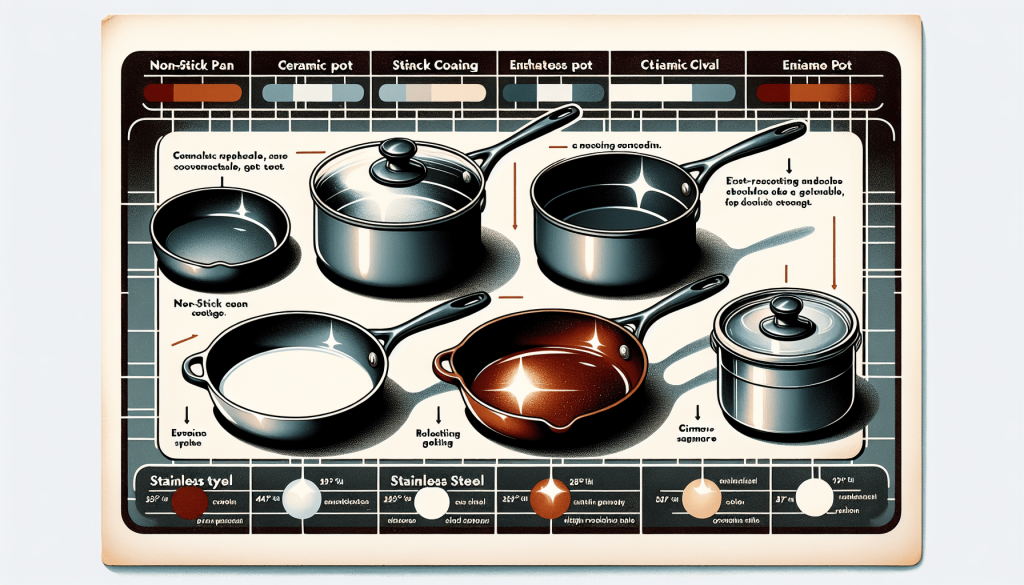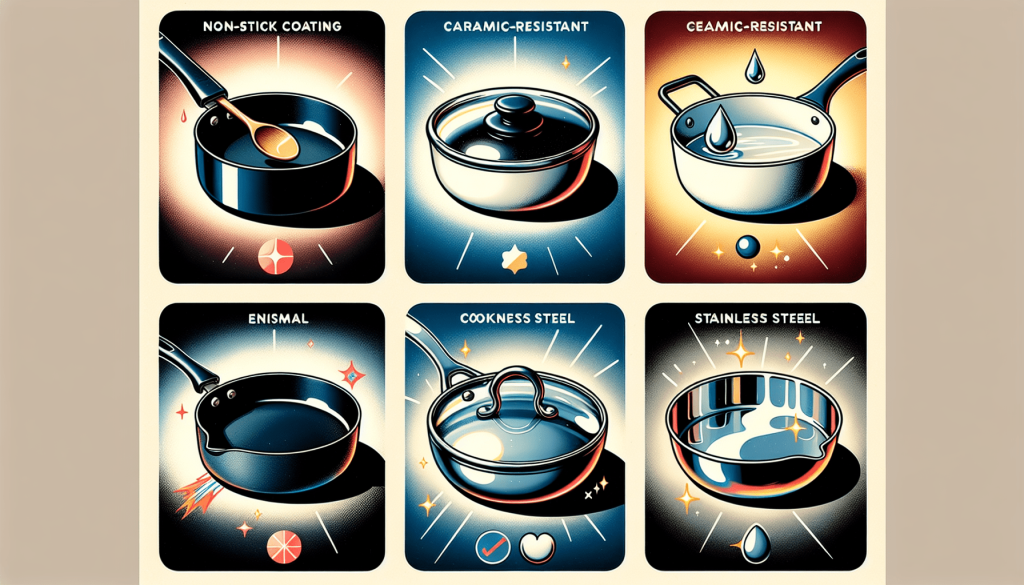Are you tired of your pots and pans sticking? Are you unsure about which type of cookware coating is best for you? Look no further! In this ultimate guide, you will discover everything you need to know about cookware coatings. From the non-stick properties of Teflon to the durability of stainless steel, we will explore the pros and cons of different coatings, helping you make an informed decision for your kitchen. Say goodbye to burnt food and hello to effortless cooking with this comprehensive guide.
1. Introduction to Cookware Coatings
1.1 What are Cookware Coatings?
Cookware coatings refer to the protective layers applied to the surface of pots, pans, and other cookware items. These coatings are designed to enhance the performance and durability of the cookware, as well as to provide a nonstick surface that makes cooking and cleaning easier. Cookware coatings come in various types, each offering unique properties and benefits.
1.2 Importance of Cookware Coatings
Cookware coatings play a crucial role in the cooking process. One of the primary advantages of using coated cookware is the nonstick feature, which prevents food from sticking and burning, allowing for effortless cooking and clean-up. Additionally, these coatings provide a protective barrier between the food and the metal surface of the cookware, reducing the risk of metal leaching into the food.
1.3 Types of Cookware Coatings
There are several types of coatings commonly used in cookware, each with its own set of characteristics and advantages. Some popular types of cookware coatings include nonstick coatings, stainless steel coatings, cast iron and enamel coatings, heat-resistant coatings, induction-compatible coatings, scratch-resistant coatings, and more. Each coating type serves a specific purpose and is suitable for different cooking styles and preferences.
2. Nonstick Coatings
2.1 Teflon Coating
Teflon coating, also known as PTFE (polytetrafluoroethylene) coating, is one of the most popular and widely used nonstick coatings in the culinary world. It offers excellent nonstick properties, allowing you to cook with minimal to no oil, making it a healthier option. Teflon coatings are highly durable and resistant to scratches. However, it’s important to use utensils that are safe for nonstick cookware to avoid damaging the coating.
2.2 Ceramic Coating
Ceramic coatings are made from inorganic materials such as silicon and oxygen, mixed with other compounds. These coatings are known for being eco-friendly and free from harmful substances such as PTFE and PFOA (perfluorooctanoic acid). Ceramic coatings provide a smooth and naturally nonstick surface, making them ideal for low-fat cooking. However, they may not be as durable as Teflon coatings and can be prone to chipping or scratching over time.
2.3 Silicone Coating
Silicone coatings are known for their high heat resistance and flexibility. They are applied to cookware as a protective layer that prevents food from sticking. Silicone coatings are considered safe and non-toxic, making them a popular choice for baking sheets and molds. However, they are not as commonly used in pans and pots due to their lower durability and nonstick effectiveness compared to other options.

3. Stainless Steel Coatings
3.1 Anodized Aluminum Coating
Anodized aluminum coatings are applied by means of an electrochemical process that enhances the natural oxide layer on aluminum cookware. This process creates a hard, non-reactive surface that is resistant to scratches and corrosion. Anodized aluminum coatings provide excellent heat distribution and retention, making them suitable for a variety of cooking techniques. However, they are not inherently nonstick and may require the use of oil or cooking sprays to prevent sticking.
3.2 Copper Coating
Copper coatings are valued for their superior heat conductivity, allowing for precise temperature control during cooking. Copper-coated cookware is often lined with stainless steel to provide a durable and non-reactive cooking surface. While copper coatings can provide excellent heat distribution, they require regular polishing to maintain their aesthetic appeal. Moreover, they are not naturally nonstick and may require the use of additional oil or butter during cooking.
3.3 Clad Stainless Steel Coating
Clad stainless steel coatings consist of multiple layers of stainless steel and other conductive metals, such as aluminum or copper. This construction enhances heat distribution and provides the durability of stainless steel. Clad stainless steel coatings offer the benefits of both stainless steel and the conductive material used, making them suitable for various cooking tasks. However, they may not provide the same level of nonstick performance as other coatings and might require the use of oil or cooking sprays.
4. Cast Iron and Enamel Coatings
4.1 Cast Iron Coating
Cast iron coatings are renowned for their exceptional heat retention and even heat distribution. The seasoning process, which involves applying oil and heating, creates a natural nonstick layer that improves with time and use. Cast iron cookware requires special care, including seasoning and avoiding acidic or alkaline ingredients that can damage the coating. Despite the maintenance needed, cast iron coatings are highly durable and can last for generations.
4.2 Enamel Coating
Enamel coatings are applied over cast iron or steel to provide a smooth and glossy surface that is resistant to staining. These coatings are ideal for slow-cooking and braising, as they distribute heat evenly and prevent food from sticking. Enamel-coated cookware is available in a variety of vibrant colors, adding a decorative touch to the kitchen. However, enamel coatings require careful handling to prevent chipping or cracking, and acidic foods should be avoided.

5. Heat-Resistant Coatings
5.1 Thermolon Coating
Thermolon coatings are ceramic-based nonstick coatings that excel in high-heat cooking. These coatings can withstand temperatures up to 450°C (850°F), making them suitable for searing and browning. Thermolon coatings are free from harmful chemicals and are highly durable, providing enhanced scratch resistance. Their nonstick properties allow for easy release of food and effortless cleaning, making them a popular choice for professional chefs and home cooks alike.
5.2 Greblon Coating
Greblon coatings are made from a combination of ceramic and mineral particles, providing excellent nonstick properties and exceptional heat resistance. These coatings can withstand high temperatures, making them ideal for oven use and high-heat cooking. Greblon coatings are PFOA-free and highly durable, ensuring longevity and ease of use. Their nonstick surface allows for healthy cooking with minimal oil or fat, and they are generally dishwasher-safe for easy cleaning.
6. Induction-Compatible Coatings
6.1 Iron Coating
Iron coatings are specifically designed for induction cooktops, as they are magnetic and allow for efficient heat transfer. These coatings provide even heating and are highly responsive to changes in temperature. Iron-coated cookware is known for its durability and ability to develop natural nonstick properties over time. It is important to note that these coatings may require regular seasoning to maintain their nonstick surface.
6.2 Stainless Steel and Aluminum Coating
Stainless steel and aluminum coatings are commonly used in induction-compatible cookware. These coatings are highly conductive and allow for quick and even heat distribution. Stainless steel provides durability and resistance to corrosion, while aluminum enhances heat conductivity. While these coatings may not be inherently nonstick, they can develop some nonstick properties with proper care, such as preheating and the addition of fats or oils.
7. Scratch-Resistant Coatings
7.1 Ceramic Titanium Coating
Ceramic titanium coatings are renowned for their exceptional scratch resistance and durability. These coatings are made by combining ceramic and titanium particles to create a robust and long-lasting surface. Ceramic titanium coatings provide excellent nonstick properties, allowing for healthy cooking with less oil or fat. They are also resistant to high temperatures and can be used in the oven. These coatings are generally dishwasher-safe, making clean-up a breeze.
7.2 Diamond Coating
Diamond coatings are among the most durable and scratch-resistant options available in cookware. These coatings are infused with diamond particles, making them incredibly tough and resilient. Diamond-coated cookware provides excellent heat conduction and even distribution, allowing for precise cooking results. Moreover, the nonstick properties of diamond coatings reduce the need for excessive oil or fat during cooking, promoting healthier cooking methods.
8. Maintenance and Care of Cookware Coatings
8.1 Cleaning Tips
Proper cleaning is essential for maintaining the longevity of cookware coatings. It is generally recommended to hand wash coated cookware with mild dish soap and a non-abrasive sponge or cloth. Avoid using harsh chemicals, abrasive cleaners, or metal scouring pads, as these can damage the coating. If food is stuck, soak the cookware in warm water and gently scrub to remove residues. Additionally, avoid sudden temperature changes, as this can cause warping or cracking.
8.2 Avoiding Scratches
To prevent scratches, use wooden, silicone, or nylon utensils when cooking with coated cookware. Metal utensils can easily damage the coating, compromising its nonstick properties. Avoid stacking or nesting cookware items when storing, as this can cause scratches or chips. Use protective pads or towels between stacked pieces to prevent damage. It is also recommended to store coated cookware away from direct contact with other metal cookware or sharp objects.
8.3 Repairing Damaged Coatings
If a cookware coating becomes damaged, it is generally not repairable at home. Continued use with a damaged coating can affect cooking performance and compromise food safety. In such cases, it is best to replace the cookware or consult a professional for possible repair options. Regular maintenance and careful handling will help prolong the lifespan of cookware coatings and ensure optimal performance.
9. Choosing the Right Cookware Coating
9.1 Considerations for Different Cooking Styles
When choosing a cookware coating, it is important to consider your preferred cooking style and the types of dishes you commonly prepare. Nonstick coatings, such as Teflon or ceramic, are ideal for low-fat cooking and easy clean-up. Stainless steel and cast iron coatings offer durability and versatility for various cooking techniques. Heat-resistant coatings, such as Thermolon or Greblon, are suitable for high-heat cooking. Consider your specific needs and preferences to select the most appropriate coating type.
9.2 Safety Concerns
Safety is a crucial aspect to consider when selecting cookware coatings. Ensure that the coating used is free from harmful substances such as PFOA, PTFE, or heavy metals. Look for coatings that are certified as food-safe and meet relevant safety standards. It is also important to follow the manufacturer’s instructions regarding temperature limits, as overheating the coating can release harmful fumes or degrade its longevity.
9.3 Budget and Longevity
Budget and longevity are key factors to consider when investing in cookware coatings. While high-quality coatings may have a higher upfront cost, they often offer greater durability and longevity, making them an economical choice in the long run. Cheaper coatings may require more frequent replacement, which can be inconvenient and potentially cost more over time. Strike a balance between budget and longevity to ensure you make a wise investment.
10. Conclusion
Cookware coatings play a crucial role in the kitchen, providing nonstick properties, durability, and enhanced cooking performance. By understanding the different types of coatings available, such as nonstick, stainless steel, cast iron, heat-resistant, induction-compatible, scratch-resistant, and more, you can make an informed decision when selecting cookware for your culinary adventures. Remember to consider your cooking style, safety concerns, and budget, and be sure to follow proper maintenance and care techniques to keep your cookware coatings in optimal condition. With the right cookware coating, your culinary creations will be a joy to create and enjoy!
